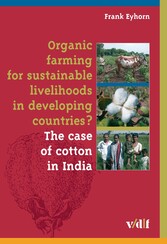Search and Find
Service
More of the content

Organic farming for sustainable livelihoods in developing countries? - The case of cotton in India
Contents
4
Preface
8
Glossary
10
Abbreviations and symbols
13
Acknowledgements
14
Executive summary
16
1 Is organic farming a viable option for developing countries?
20
1.1 Organic farming in developing countries
20
1.1.1 Challenges for farmers in developing countries
20
1.1.2 Possible options to approach the challenges
22
1.1.3 The concept and the potential of organic farming
22
1.2 The case of cotton
24
1.2.1 The importance of cotton
25
1.2.2 Problems in conventional cotton farming
26
1.2.3 Genetically modified cotton
28
1.2.4 Is organic cotton farming an alternative?
29
1.3 The case study and the research region
32
1.3.1 The Maikaal bioRe organic cotton initiative
33
1.3.2 The research region
34
1.3.3 Organic and conventional cotton cultivation
36
1.4 Research objectives and questions
38
2 Conceptualizing rural livelihoods
40
2.1 In search of a conceptual approach
40
2.1.1 Livelihoods in transition
40
2.1.2 How livelihood approaches developed
43
2.1.3 Why does it matter how to approach livelihood?
44
2.2 Strengths and shortcomings of the Sustainable Livelihoods Approach
45
2.2.1 Insights gained through the Sustainable Livelihoods Approach
45
2.2.2 Livelihoods are more than assets
47
2.2.3 Beyond utility maximisation
48
2.3 Re-thinking livelihood approaches
50
2.3.1 Inner and outer reality of rural livelihoods
50
2.3.2 How do livelihood strategies develop?
53
2.4 A new synthesis
56
2.4.1 Suggesting a refined livelihood framework
56
2.4.2 Application of the framework in the research project
59
3 Research approach and methods
60
3.1 The research approach
60
3.1.1 Quantitative and qualitative research
60
3.1.2 Study parts
61
3.2 Methodology of the system comparison
62
3.2.1 Approach and hypotheses of the system comparison
62
3.2.2 Data collection
65
3.2.3 Farm sample selection
69
3.2.4 Soil sampling and analysis
70
3.2.5 Data processing
72
3.3 Methodology of the adoption analysis
73
3.3.1 Approach of the adoption analysis
73
3.3.2 Exploratory interviews
76
3.3.3 Controversial statement analysis
76
3.3.4 Group discussion based on video screening
77
3.3.5 Observation protocols
77
3.3.6 Research feedback
77
3.3.7 Interviews on changes in the livelihood system
78
3.3.8 Comparison with other organic cotton initiatives
78
4 The impact of organic farming
80
4.1 Differences in cultivation practices
80
4.1.1 Cropping patterns
80
4.1.2 Manure and fertilizer input in cotton cultivation
83
4.1.3 Irrigation in cotton cultivation
84
4.1.4 Labour input in cotton cultivation
86
4.2 Impact on soil fertility
88
4.2.1 Texture, water retention and organic matter
89
4.2.2 Soil nutrients, salinity and pH
92
4.3 Differences in productivity
95
4.3.1 Impact on cotton yields
95
4.3.2 Productivity of rotation crops
101
4.3.3 Possible ways for improving the productivity
103
4.4 The economic impact of organic farming
104
4.4.1 Production costs in organic cotton
104
4.4.2 Profitability of organic cotton cultivation
106
4.4.3 Economic performance of the farm
109
4.5 Summary: The impact of organic farming
114
5 Understanding the adoption of organic farming from a livelihood perspective
118
5.1 Decision-making in the core of livelihoods
118
5.1.1 Socio-economic profiles of adopters and non-adopters
119
5.1.2 Perceptions and attitudes of cotton farmers
124
5.2 The role of the livelihood context in decision-making
128
5.2.1 The role of the risk and opportunity context
128
5.2.2 Relation to the context of policies, institutions, organisations and processes
131
5.3 Organic agriculture as a part of a livelihood strategy
134
5.3.1 The strategy development process
134
5.3.2 Implementing the strategy ‘organic farming’
138
5.3.3 Obstacles to conversion
142
5.4 Outcomes of adopting organic farming
146
5.4.1 Perception and interpretation of outcomes of organic farming
146
5.4.2 Changes in vulnerability and dependencies
150
5.4.3 Learning processes
152
Learning processes of the farmers
153
5.5 Dropping out of organic farming
155
5.5.1 Profiles of defaulters
155
5.5.2 Motivations for dropping out of organic farming
158
5.5.3 Outcomes of defaulting
159
5.6 Summary: Adopting organic farming
160
6 Utilizing organic farming as a viable development option
164
6.1 Potentials and limitations of organic farming for improving livelihoods
164
6.1.1 The impact of organic farming on livelihoods
164
6.1.2 Integrating organic farming into a livelihood strategy
169
6.2 Success factors and constraints in disseminating organic farming
173
6.2.1 Recommendations for support activities
173
6.2.2 Policy implications
178
6.3 Concluding remarks
181
References
184
Annex
192
1 Background information on the Maikaal bioRe project and its region
192
1.1 Details of the Maikaal bioRe project (2003–2005)
192
1.2 Average farm size in the Maikaal bioRe project
192
1.3 Rainfall in the project region
193
1.4 Crops grown in the project region
193
1.5 Population data of Maheshwar and Kasravad Tehsil
194
1.6 Castes in the project region
194
2 Methodology
195
2.1 Approximation formula for irrigation water quantities
195
3 Results of the system comparison study
201
3.1 Cropping patterns in cotton farms
201
3.2 Labour, nutrient and irrigation input in cotton cultivation
201
3.3 Soil parameters in cotton fields
202
3.4 Seed cotton yields in different sub-groups of cotton fields
202
3.5 Yield models for organic and conventional cotton farming
203
3.6 Economic performance of cotton cultivation
204
3.7 Performance of rotation crops
205
3.8 Economic impact on the farm
206
3.9 Profiles of organic, conventional and defaulting farms
207
4 Results of the adoption analysis (qualitative research)
209
4.1 Perceptions and attitudes of conventional farmers
210
4.2 The relation of cotton farms to their context
212
4.3 Integrating organic farming into the livelihood strategy
213
4.4 Implementing organic farming as a part of a livelihood strategy
214
4.5 Obstacles to converting to organic farming
214
4.6 Changes in the livelihood situation perceived by organic farmers after adoption
215
4.7 Organic farms and their relation to the context
218
4.8 Learning processes
218
4.9 Dropping out of organic farming (‘defaulting’)
219
5 Methodological reflection on the research approach
220
5.1 Suitability of the RL-Framework
220
5.2 Reflection on the research methods
222
All prices incl. VAT











